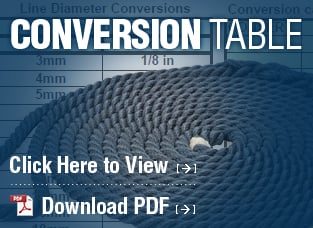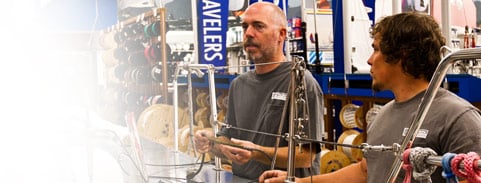Standing Rigging Measurement:When measuring standing rigging, we like to use a process to avoid confusion as to what the measurement points are, and where any fittings, such as turnbuckles may be at the time of measurement. When removing the rigging from the mast, tape or mark the threaded studs of the turnbuckle where they exit the body to be able to replicate those locations once loosened and removed. As for the measurement, when pins are used at top and bottom, use the pin center as the measurement point. For example, the shroud is 24' 3 1/2" pin center to pin center. Where a t-ball fitting is used, measure from the bearing point of the t-ball where it sits in the tang. A normal rule we use when building new rigging is to have the turnbuckles set to 2/3 open. This allows for the appropriate throw to tension. Certain production boats and one-designs will come with a specification of what the original rigging lengths were, or should be. **SPECIAL NOTE: We would prefer to have the old rigging measured, or brought in to be measured if at all possible rather than rely on a "standard spec", as all boats are NOT built the same. Lifeline Measurement:Sometimes this feels like an art! As with the standing rigging, if you are able to bring the lifelines you would like to duplicate in for measurement. This is the best way to ensure proper lengths. If not, bearing points in these measurements becomes more critical than pin centers as in standing rigging. For lifelines without gates, the measurement is simply from the bearing point of the front pulpit attachment point to the aft pushpit attachment point. A good trick to replicate a lifeline is to attach it tightly to the forward bearing point. As you run it aft, bend it around the outboard side of the stanchions at the appropriate lifeline's height. Once all the way aft, pull tight and measure to the aft bearing point. For lifelines with gates, proceed with the above mentioned length overall first.Next you will measure from the forward pulpit attachment point, running the tape along the outboard side again, to the aft edge of the forward gate stanchion. It is important to get the measurement to this point, and not the stanchion center point, or forward side. The last measurement starts at this same point (the aft edge of the forward gate stanchion) and ends at the forward side of the aft gate stanchion. It is the length of the gate, from the inside bearing points, not the actual length of the wire portion of the gate. This is important as deductions are taken out during the production to ensure that the gate eyes sit flush with the stanchions. You will also need to note whether you would like the pelican hook forward or aft. Another note is to make sure you measure every lifeline separately, even port and starboard. Slight variations in the production of the boat would make the measurements on one side, not correct for the other side. Working Load Limit (WLL) formerly referred as Safe Working LoadThe working load limit (WLL) refers to the maximum load a rigging system should experience in normal use. This limit is a percentage of the minimum breaking strength of the weakest component in the system. For wire rope and fiber rope in good condition, with appropriate terminations, used for noncritical applications the maximum working load is 20% of published strength. For alloy fittings a maximum working load (MWL) may be provided by the vendor and published in our catalog. If no MWL is provided consult a rigging professional to ensure the correct load limit is used for the fitting and application. A synthetic fiber rope subjected to a sudden load that exceeds 30% of the breaking strength is considered to have been shock loaded and could fail without warning even when loaded within the WLL. Shock loading can occur when rope is used as a tow line or to stop a moving object. The effects of shock loading are greater in shorter length ropes and ropes with lower stretch. When working with critical loads that could cause damage to property or risk of injury the WLL must be lowered to provide a greater safety factor. Consult the manufacturer before using any rigging product in special applications or severe exposure conditions. |
Formula Diameter and Conversion Table
West Advisor Articles Selecting the right running rigging for your sailboat can be a challenge. There are a lot of choices, and your selection is often more a matter of taste than function. How do you decide which line is best for your application? Roller furling systems have made managing headsails easier for about 30 years. If your boat has never had a furling system, or if the furler that’s installed needs replacement, there are more choices available than ever, and the products are all pretty efficient. Whatever type of sailboat you own, there’s a roller furling system that will simplify your sailing. Lifelines form a safety perimeter around your boat and should be inspected on an annual basis. Preventive maintenance is not just a prudent boating practice, but in the case of lifeline systems it could be a lifesaver. Winches allow you to exert force on lines by combining gear reduction and leverage. By using a longer handle which turns a smaller diameter drum, and by utilizing ratchets to keep the drum from turning the wrong way, winches let you tame sails that would otherwise be too hard to control. Stainless steel is an alloy that contains at least 50% iron and 10% chromium, which inhibits corrosion. The more chromium, the more corrosion-resistance, up to a maximum of about 30%. Many other elements are added to enhance the durability properties of a particular grade and type of stainless steel
|







